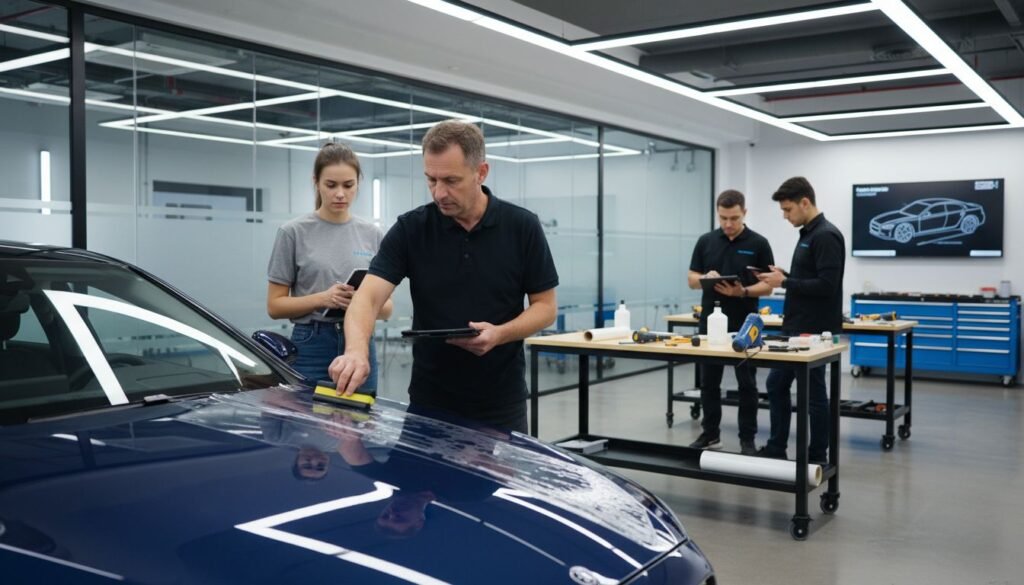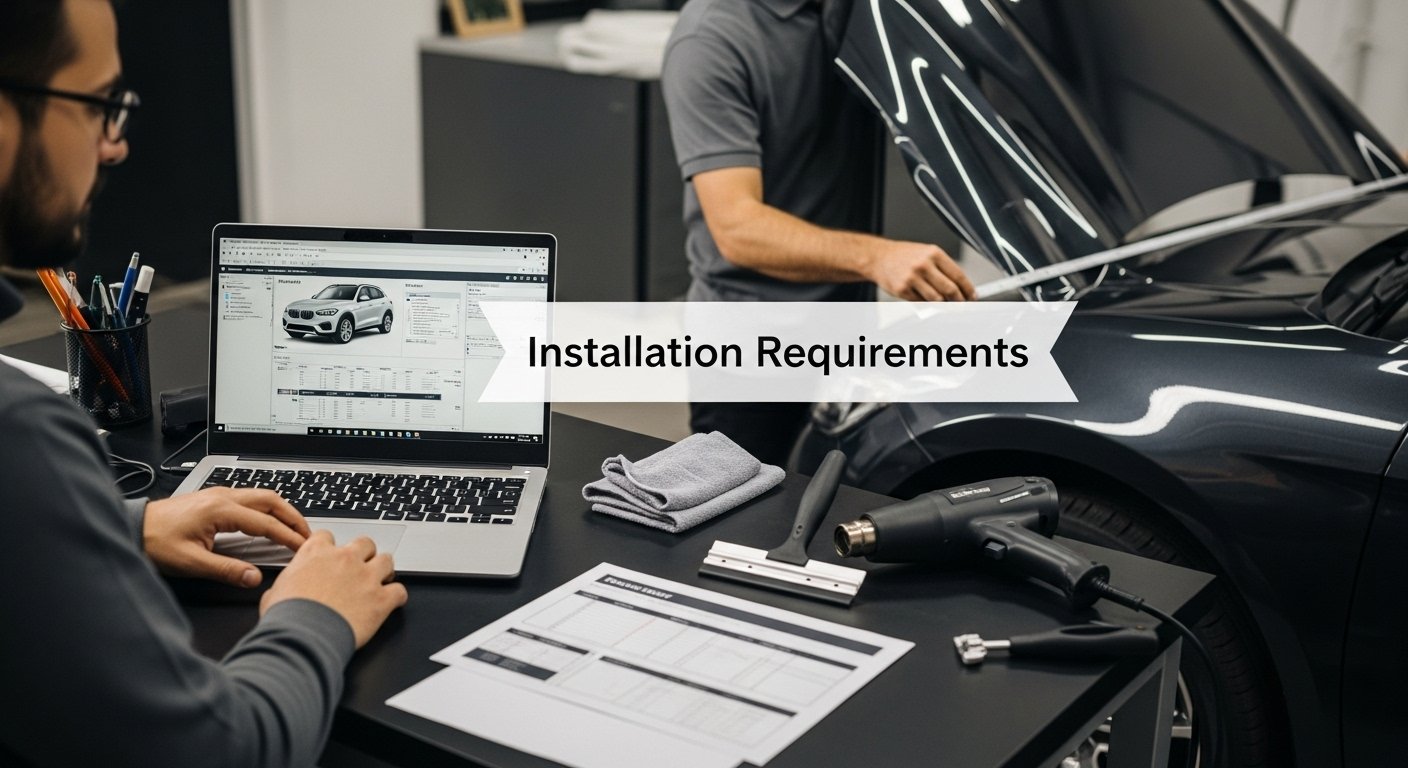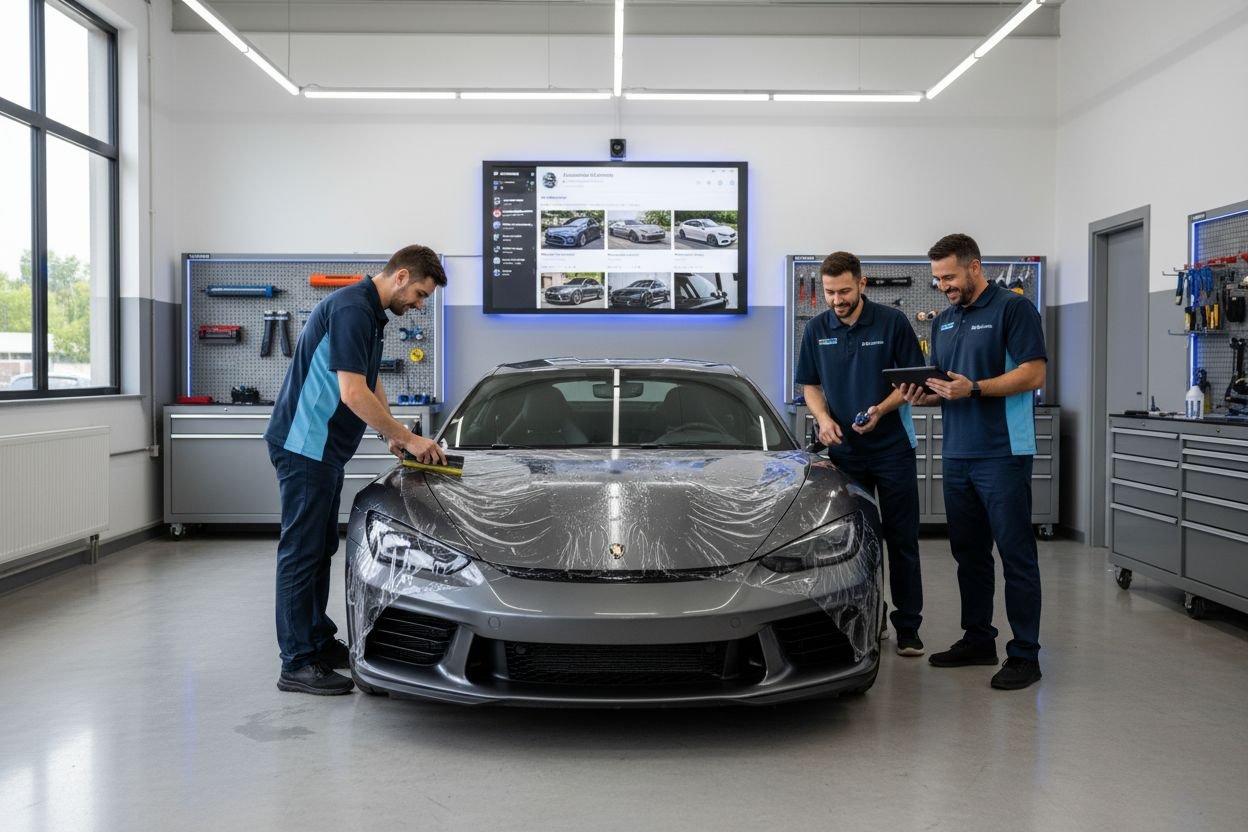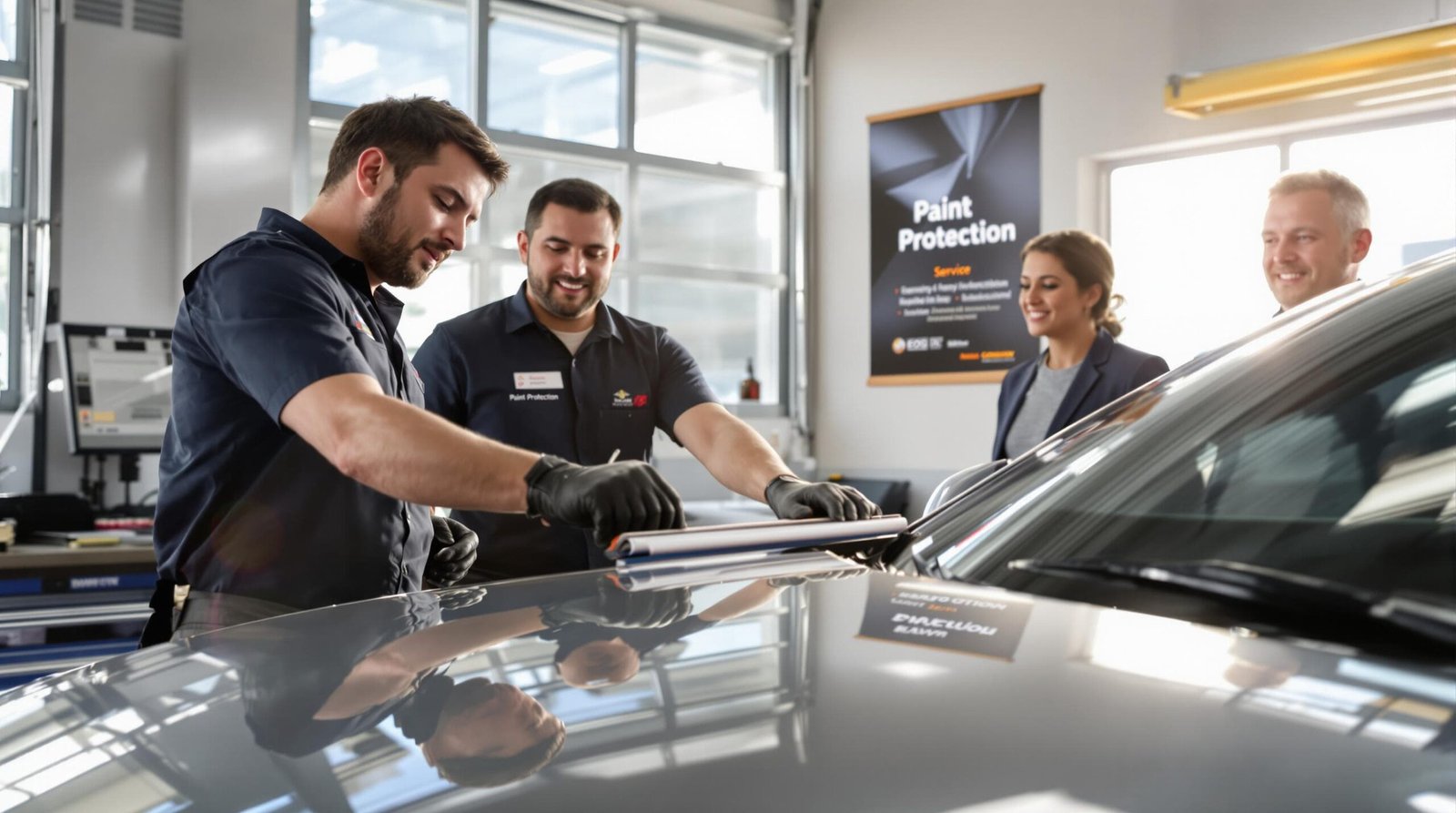
Over 60 percent of aspiring paint protection film installers fail to reach professional status due to gaps in training and skill validation. In the growing automotive protection market, choosing the right PPF training path can shape your career success. This guide breaks down each stage from assessing training options to certifying your expertise, so you can build real skills and stand out as a trusted PPF specialist.
Table of Contents
- Step 1: Assess Available PPF Installer Training Options
- Step 2: Choose the Right Training Provider for Your Business
- Step 3: Set Up Required Tools and Software for Training
- Step 4: Complete Hands-On PPF Installation Practice Sessions
- Step 5: Verify Skills Mastery and Certification Achievements
Quick Summary
| Key Insight | Explanation |
|---|---|
| 1. Assess Training Options Thoroughly | Research comprehensive PPF training programs focusing on both theory and hands-on experience for optimal skill development. |
| 2. Choose Experienced Instructors | Select training providers with instructors who possess extensive real-world PPF installation experience to gain valuable insights. |
| 3. Invest in Quality Tools | Equip your workspace with professional-grade tools and software to support effective learning and future installations. |
| 4. Prioritize Hands-On Practice | Engage in intensive practical sessions that mimic real-world scenarios to master PPF installation techniques and achieve proficiency. |
| 5. Verify Skills and Obtain Certification | Complete comprehensive assessments and obtain certification to validate your skills and enhance your professional credentials. |
Step 1: Assess Available PPF Installer Training Options
Assessing available paint protection film (PPF) installer training options is a critical first step in launching your professional career or upgrading your skills. Your goal here is to research comprehensive programmes that provide both theoretical knowledge and practical hands-on experience in PPF installation techniques.
When exploring training options, look for courses that offer in-depth curriculum and real-world training scenarios. According to TMR Films, professional training programmes like their 2-day hands-on course are designed to cater to beginners and intermediate installers. Such courses typically cover fundamental and advanced installation techniques while providing immediate feedback to help you refine your skills.
Key considerations when assessing training options should include the programme duration, instructor expertise, curriculum depth, practical training components, and potential certification. Seek programmes that offer a balanced mix of classroom learning and actual installation practice. Look for courses that provide insights into different film types, surface preparation techniques, tools and equipment usage, and industry best practices. Some advanced programmes might also cover business development strategies for PPF installers.
Warning: Not all training programmes are created equal. Always verify the credentials of the training provider, read reviews from past participants, and if possible, speak with graduates to understand the real-world value of the course.
As you complete this assessment phase, you will be well-prepared to select a training programme that matches your current skill level and professional aspirations in the PPF installation industry.
Step 2: Choose the Right Training Provider for Your Business
Choosing the right training provider is crucial for developing professional PPF installation skills that will set you apart in a competitive automotive protection market. Your selection will directly impact the quality of knowledge and practical experience you gain.
When evaluating potential training providers, prioritise programmes that offer comprehensive and practical learning experiences. Look for instructors with extensive real world experience in PPF installation who can provide nuanced insights beyond basic technical skills. Some key factors to consider include the instructor’s professional background, years of hands-on experience, and ability to communicate complex techniques effectively.
Beyond instructor credentials, assess the training programme’s curriculum depth and practical components. Seek programmes that provide a balanced mix of theoretical knowledge and hands-on installation practice. Ideal training should cover essential topics like film selection, surface preparation, installation techniques, tool usage, and potential business development strategies. Training how-to guide on Aeoncut can offer additional insights into effective learning methodologies for PPF installation.
Warning: Be cautious of programmes that seem overly theoretical or lack substantial practical training components. A quality PPF installation course should provide ample opportunity for supervised hands-on practice with professional-grade materials and equipment.
By carefully evaluating training providers using these criteria, you will position yourself to select a programme that genuinely enhances your professional capabilities and prepares you for success in the PPF installation industry.
Step 3: Set Up Required Tools and Software for Training
Preparing your workspace with the right tools and software is essential for successful PPF installation training. This step involves gathering professional grade equipment and digital resources that will support your learning journey and future professional practice.
Start by investing in core physical tools necessary for PPF installation. Your toolkit should include high quality squeegees, precision cutting tools, heat guns, surface preparation materials like microfibre cloths and cleaning solutions, and protective work surfaces. These fundamental tools will enable you to practice techniques effectively and develop muscle memory for professional installations.
On the software side, consider integrating advanced digital solutions that streamline your workflow. Aeoncut tutorials can provide comprehensive guidance on using cutting edge PPF software for precise pattern generation and installation planning. Digital tools like pattern libraries and cutting software can significantly reduce material waste and improve overall installation accuracy.
Warning: Avoid purchasing low quality tools or relying exclusively on budget equipment. Professional grade tools might represent a higher initial investment but will ultimately provide better training outcomes and more reliable performance during actual installations.
By carefully selecting and setting up your tools and software, you are laying a strong foundation for your PPF installation training and future professional success in the automotive protection industry.

Step 4: Complete Hands-On PPF Installation Practice Sessions
Hands-on PPF installation practice sessions are the critical bridge between theoretical knowledge and professional expertise. These practical training experiences will transform your understanding of paint protection film techniques from conceptual learning to real world application.
As recommended by Performance Syndicate, intensive practice modules provide immersive learning opportunities. Their 7-day offline practice programme in Los Angeles demonstrates the value of expert mentorship during hands-on training. During these sessions, focus on mastering key skills such as surface preparation, film alignment, precise cutting, heat application, and seamless installation techniques.
Each practice session should simulate real world scenarios with different vehicle surfaces and challenging installation areas. Practice on various vehicle panels including complex curves, edges, and intricate sections like side mirrors and door handles. Pay close attention to technique details like maintaining proper tension, avoiding air bubbles, and achieving smooth film transitions. Common mistakes in PPF installation can provide additional insights into potential pitfalls to avoid during your practice.
Warning: Do not rush through practice sessions. Precision and patience are more important than speed. Take time to understand each movement and technique, documenting your progress and learning from each installation attempt.
These hands-on practice sessions will build the muscle memory and technical skills necessary to become a professional PPF installer, transforming theoretical knowledge into practical expertise.
Step 5: Verify Skills Mastery and Certification Achievements
Reaching the final stage of your PPF installation training involves systematically verifying your acquired skills and obtaining professional certification. This crucial step transforms your training efforts into tangible professional credentials that demonstrate your expertise to potential employers or clients.
As illustrated by Paintless Dent School, professional training programmes often culminate in comprehensive certification processes. Their 5-day PPF training programme provides a structured approach to skills validation, offering certification upon successful course completion. During this verification stage, expect comprehensive assessments that test both theoretical knowledge and practical installation techniques.
The skills verification typically involves multiple evaluation components including written examinations, practical installation demonstrations, and technical skill assessments. Focus on showcasing your proficiency in surface preparation, film application techniques, precision cutting, heat manipulation, and overall installation quality. How to create custom PPF patterns can provide additional insights into demonstrating advanced technical capabilities during your certification process.
Warning: Do not underestimate the importance of documentation during your skills verification. Maintain detailed records of your practice sessions, keep a portfolio of your best installations, and be prepared to explain your technical decision making process.
Successfully completing your skills mastery and certification represents more than just obtaining a document. It signifies your commitment to professional excellence and positions you as a credible PPF installation specialist in a competitive automotive protection market.

Master Your PPF Installation Skills with Advanced Digital Tools
Navigating the world of paint protection film (PPF) installer training requires dedication to both technique and efficiency. The article highlights critical challenges such as gaining hands-on experience, selecting the right training provider, and mastering the essential tools. To truly excel, installers must combine practical skills with precise technology that reduces errors and waste while enhancing installation quality.
Step up your training by integrating powerful software solutions designed for professional installers and serious enthusiasts. The AEONCUT platform offers an extensive range of pre-cut patterns, cloud-based updates, and AI-driven features that streamline your workflow and empower you to produce flawless installations. With support for custom designs and a growing pattern library, you can confidently apply your growing expertise in real-world scenarios.
Explore how you can complement your training with cutting-edge technology by visiting our PPF software – AEONCUT PPF Pre-cut Cutting software category page.

Unlock higher precision and efficiency in every installation today. Visit https://aeoncutsw.com now to discover subscription plans tailored for professionals like you. While you are there, check out our Paint Protection Film – AEONCUT PPF Pre-cut Cutting software resources and start turning your training investment into professional success.
Frequently Asked Questions
How do I assess available PPF installer training options?
To assess PPF installer training options, research various programs that combine theoretical knowledge with hands-on experience. Look for courses that offer extensive curriculums, practical training scenarios, and experienced instructors to ensure you gain both skills and insights.
What should I consider when choosing a training provider for PPF installation?
When selecting a training provider, prioritize those with a strong curriculum and experienced instructors. Evaluate their practical training components and focus on programs that offer both theoretical learning and real-world practice to better equip yourself for the installation tasks ahead.
What tools do I need to prepare for PPF installer training?
Prepare for PPF installer training by gathering essential tools such as high-quality squeegees, precision cutting tools, and heat guns. Ensure that your toolkit is professional-grade to promote effective practice and skill development.
How can I maximize my hands-on practice sessions for PPF installation?
Maximize your hands-on practice sessions by focusing on mastering key techniques like surface preparation and film alignment. Simulate real-world scenarios by practicing on diverse vehicle surfaces to build confidence and precision in your installations.
What steps are involved in verifying my skills and obtaining certification in PPF installation?
To verify your skills and obtain certification, complete practical assessments that demonstrate your installation techniques and theoretical knowledge. Maintain a detailed record of your practice sessions and aim to showcase proficiency in all areas of PPF installation during evaluations.
Recommended
- Best PPF Software 2025: Top Picks for Auto detailing businesses – AEONCUT PPF Pre-cut Cutting software
- PPF Cutting Software: Essential Guide for Installers 2025 – AEONCUT PPF Pre-cut Cutting software
- Building a PPF Business in 2025: From Tools to First Clients – AEONCUT PPF Pre-cut Cutting software
- How to Train New Installers Using Aeoncut Tutorials Effectively – AEONCUT PPF Pre-cut Cutting software




